The Italian composer and guitarist Carlo Domeniconi (b. 1947) took his education at the Rossini Conservatory in Pesaro and at the Hochschule für Musik in Berlin and combined with his interest in Turkey (he founded the classical guitar course at the Istanbul University State Conservatoire) to create music that bridges East and West. In 1991, he wrote Sinbad, a Fairy Tale for Solo Guitar, Op. 49.
The character of Sindbad (or Sinbad), comes from the 1001 Nights’ tales. Our fictional mariner hails from Baghdad and, through the 1001 Nights’ stories, takes seven voyages through the seas ‘east of Africa and south of Asia’.
The story opens in Baghdad. In 1001 Nights, there is a framing tale where Sinbad the successful mariner tells his story to Sinbad the porter resting at his door. He tells Sinbad II of the seven voyages that brought him fame and fortune.
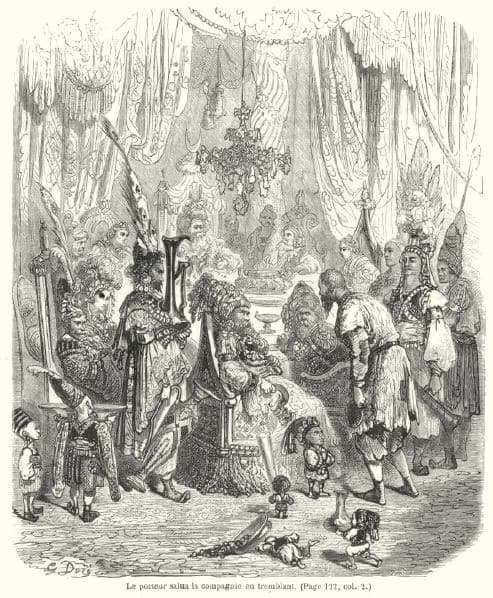
Gustave Doré: Sindbad the rich man meets Sindbad the porter, 1865
Carlo Domeniconi: Sindbad, ein Märchen (Sinbad, a Fairy Tale), Op. 49 – Cycle I: No. 1. Bagdad (Celil Refik Kaya, guitar)
Voyage 1: Sinbad goes to sea and lands on a big island that turns out to be a sleeping whale. The sailors’ fire awakens the whale who dives, stranding Sinbad in the middle of the sea, but he finds a passing piece of wood to save himself.
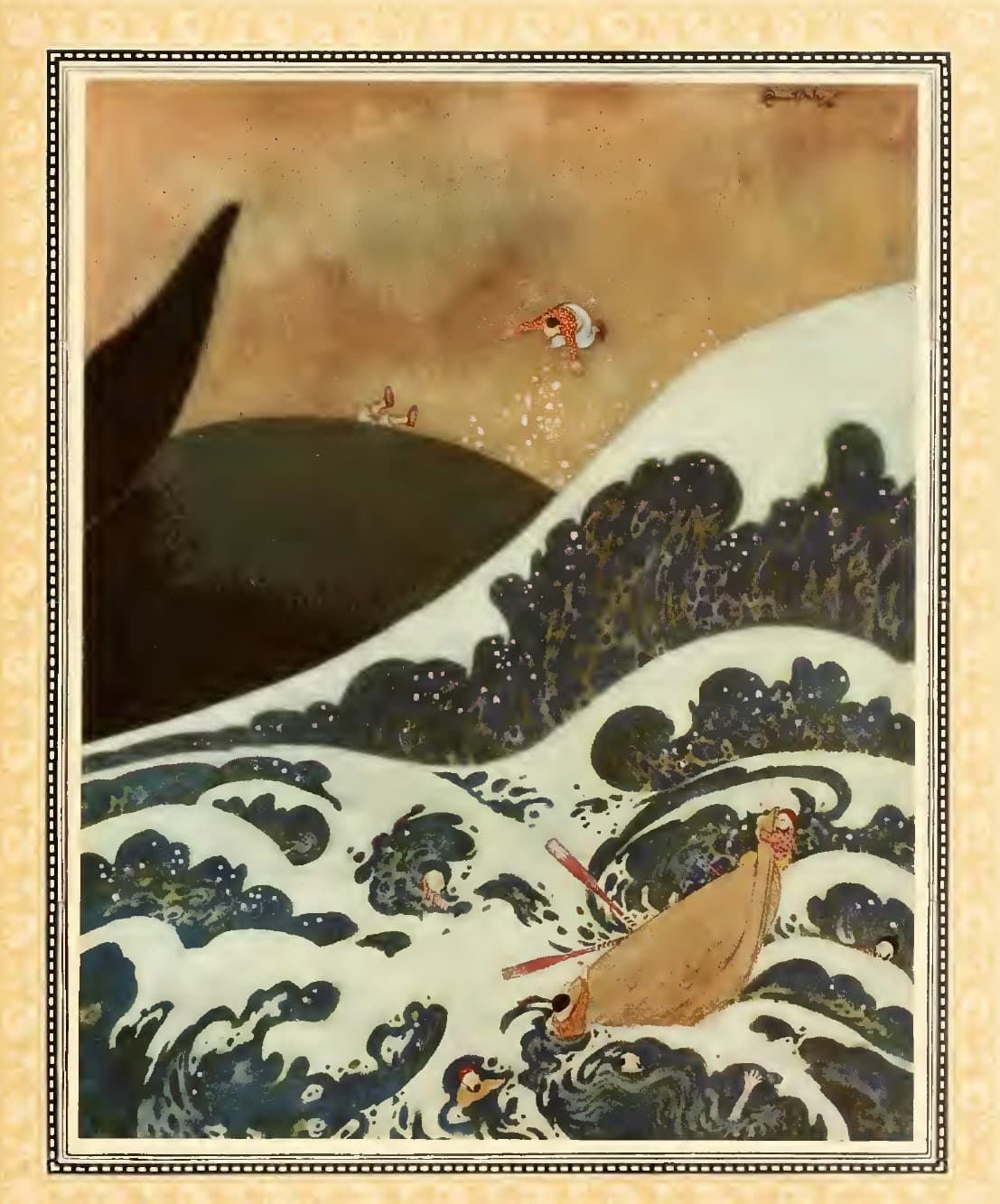
Edmund Dulac: Sindbad and the Whale, 1914
Carlo Domeniconi: Sindbad, ein Märchen (Sinbad, a Fairy Tale), Op. 49 – Cycle I: No. 4. Der Kampf mit den Wellen (The Battle with the Waves) (Celil Refik Kaya, guitar)
He lands on a wooded island, saves the king’s horse, and is made a trusted member of the court. One day, Sinbad’s original boat docks in the kingdom. Sinbad sells the king all his goods and the king gifts him with rich presents. When Sinbad returns to Baghdad, he sells the presents and makes his first fortune.
Voyage 2: Sinbad goes to sea again and finds himself stranded on an island where giant birds, rocs, lay their eggs. He attaches himself to a roc and is carried to a valley filled with diamonds.
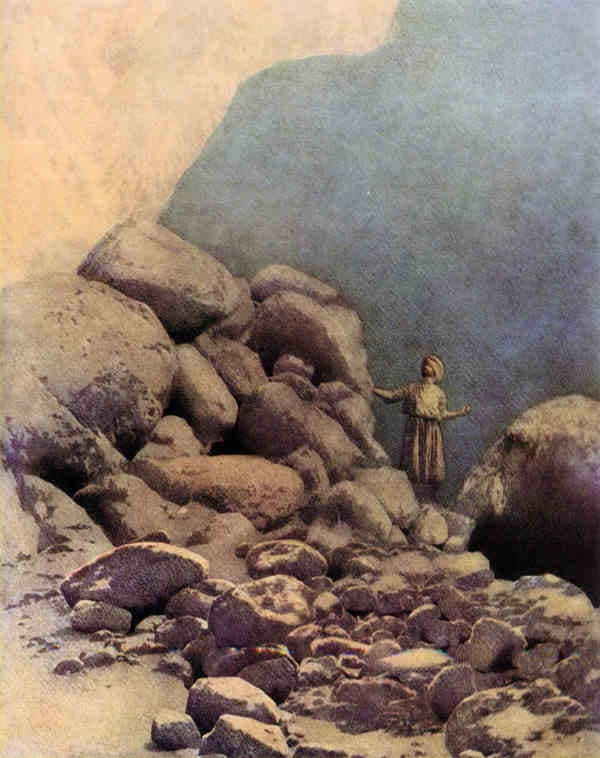
Maxfield Parrish: Sindbad the Sailor and the Valley of the Diamonds, 1907
The valley is filled with snakes, the rocs’ favourite food, and to get the diamonds, Sinbad straps himself to a roc, picks up a sack of diamonds, and then escapes when the roc returns to its nest. Thus his second fortune was made.
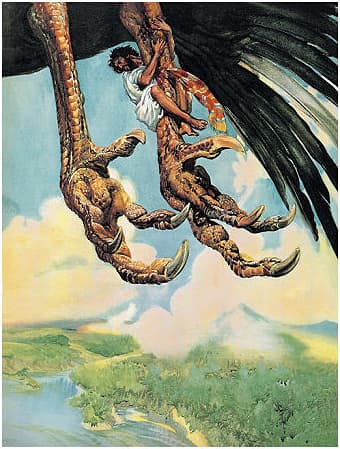
Sindbad tied to the roc’s leg
Carlo Domeniconi: Sindbad, ein Märchen (Sinbad, a Fairy Tale), Op. 49 – Cycle I: No. 6. Diamantenfischer im Schlangental (Diamond Fishers in the Valley of Snakes) (Celil Refik Kaya, guitar)
Voyage 3: On this voyage, Sinbad and his companions are captured by a Cyclope, who starts eating the crew, starting with the fattest (the captain). The remaining crew blind the monster and escape, pursued by the monster’s mate. He evades her fatal rock-throwing and returns home, making his third fortune on the way.

Maxfield Parrish: Sindbad Plots Against the Giant, 1907
Carlo Domeniconi: Sindbad, ein Märchen (Sinbad, a Fairy Tale), Op. 49 – Cycle I – No. 7. Glückliche Reise (Homeward Bound) (Celil Refik Kaya, guitar)
Voyage 4: Sinbad is again shipwrecked, this time having to escape from cannibals. He is rescued and given a beautiful wife. Unfortunately, the rule of the land is that if a spouse dies, the remaining partner is buried alive with them. His wife dies and he’s entombed with her, given only a basket of food.
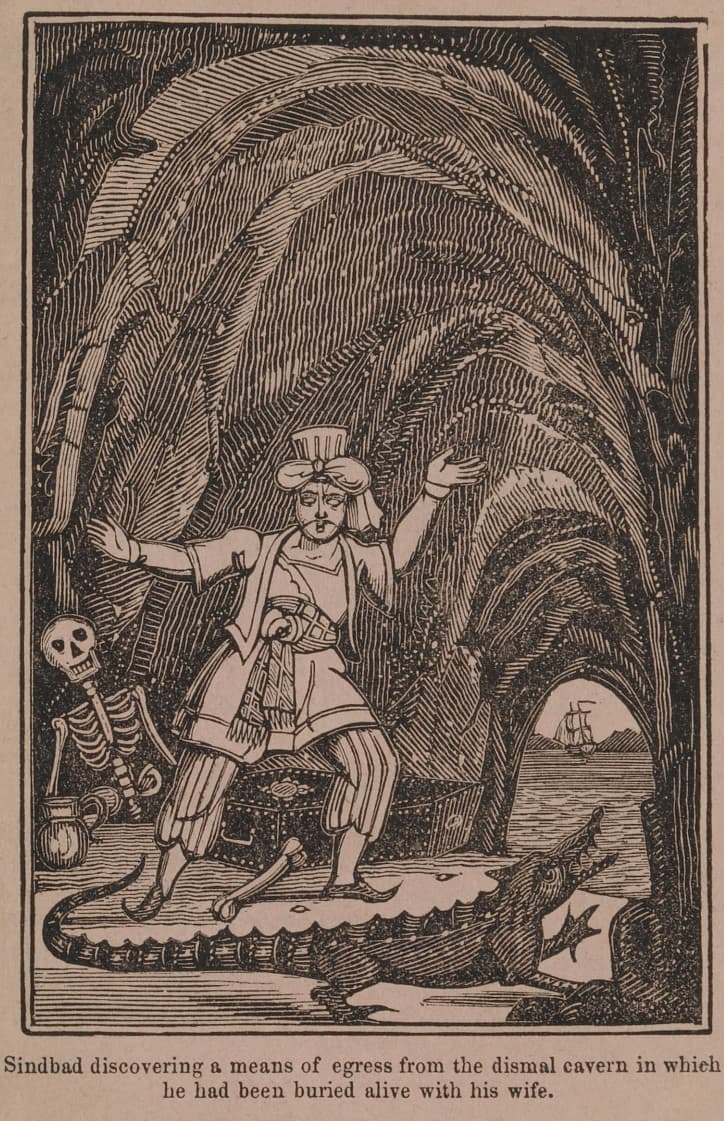
Keys: Sindbad entombed, 1840s
Carlo Domeniconi: Sindbad, ein Märchen (Sinbad, a Fairy Tale), Op. 49 – Cycle II: No. 7. Zwangsbegräbnis (Buried Alive) (Celil Refik Kaya, guitar)
He survives in the tomb on the rations of other stranded partners (while keeping their gold and jewels), until he follows an animal out of the tomb and is rescued by a passing ship. Again, he returns home with another fortune.
Voyage 5: Disembarking on a remote island and seeing a roc’s egg, the sailors break open the egg and dine on the young chick. The enraged parent roc catches up with the ship and sinks it by dropping rocks on it. Sinbad is shipwrecked again, now captured by The Old Man of the Sea, who rides on Sinbad’s back with his legs twisted around our hero’s neck.
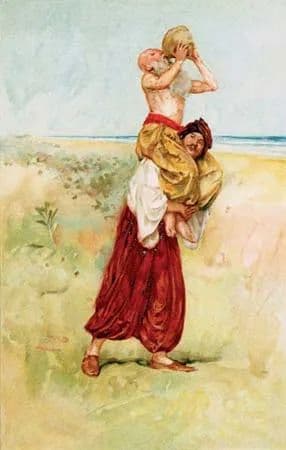
Walter Paget: Sindbad and the Old Man of the Sea, 1907
Sinbad escapes after making the Old Man drunk, only to find a city of man-eating apes. Sinbad escapes them, accrues another fortune, and returns home.
Voyage 6: Another shipwreck, and after the death of his companions, Sinbad finds an underground river lined with precious stones and flowing with ambergris.
Carlo Domeniconi: Sindbad, ein Märchen (Sinbad, a Fairy Tale), Op. 49 – Cycle III – No. 2. Der unterirdische Fluss (The Subterranean River) (Celil Refik Kaya, guitar)
He awakens in the city of Serendib and, impressing the king with his stories, is sent back to Baghdad with fabulous presents. Another fortune is made.
Carlo Domeniconi: Sindbad, ein Märchen (Sinbad, a Fairy Tale), Op. 49 – Cycle III: No. 6. Serendip (Serendipity) (Celil Refik Kaya, guitar)

Milo Winter: Having balanced my cargo exactly…, 1914
Voyage 7: On Sinbad’s last voyage, he is, to no one’s surprise, shipwrecked once again. He befriends the chief of the merchants who marries him to his daughter. Once a month, the inhabitants of the city are turned into bird-people and Sinbad has himself carried into the sky, where he hears angels. He praises God, but the bird-people are then burned by fire from heaven. Angry with Sinbad, the bird-people abandon him on a mountaintop. He’s met there by two angels who give him a staff of gold. When he returns to the city, Sindbad’s wife tells him that the bird-people are devils, but she and her father are not. Sinbad sells up all he owns and he returns with his wife to Baghdad, where he resolves to stop having adventures.
Carlo Domeniconi: Sindbad, ein Märchen (Sinbad, a Fairy Tale), Op. 49 – Cycle III: No. 7. Rückkehr nach Bagdad (Return to Baghdad) (Celil Refik Kaya, guitar)
In his music, Domeniconi uses the musical techniques of Middle Eastern music, such as ‘authentic Arabian oud ornaments’, and other musical gestures to place us into Sinbad’s world. Stylistically, the work is very variable. The work is written as three cycles, each divided into 7 parts. Domeniconi doesn’t set the seven tales in order but creates his own order. Cycles I and II each end with trips home. Throughout the entire work, the guitar is tuned in 12 different tunings; fortunately, 11 of the 12 tunings involve just one string being altered by a semitone at a time.
Our usual introduction to stories from the 1001 Nights in music is via Rimsky-Korsakov’s orchestral piece of program music, Scheherazade. That work also uses part of Sinbad’s story, particularly in the first movement: The Sea and Sinbad’s Ship, and the fourth movement, Festival at Baghdad –The Sea. Domeniconi’s setting for solo guitar is able to imbed us differently in the story, making it closer to the original setting of verbal tale-telling. Sinbad’s moral is that his riches and treasures were earned by his own hard labour. Sinbad the Porter declared that Sinbad the Merchant’s perils and troubles made his own troubles look like nothing. Sinbad was so pleased that Sinbad the Porter was invited to dine with him every day (and, doubtlessly, listen to yet more tales).
For more of the best in classical music, sign up to our E-Newsletter


